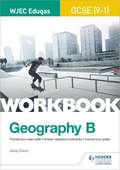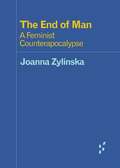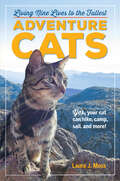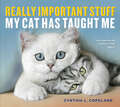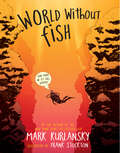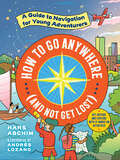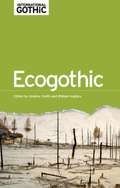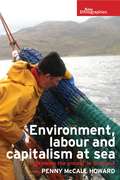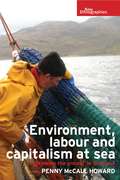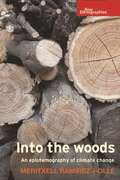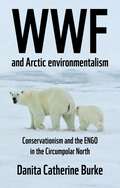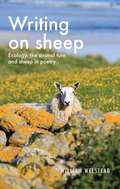- Table View
- List View
WJEC Eduqas GCSE (9-1) Geography B Workbook
by Andy OwenBuild, practise and improve exam skills throughout your WJEC Eduqas GCSE (9-1) Geography B course to boost confidence and grades in the final exams. Suitable for all abilities.
Cbac Tgau Daearyddiaeth: Llyfr Gwaith (WJEC GCSE Geography Workbook Welsh-language Edition)
by Andy OwenBuild, practise and improve exam skills throughout your WJEC / Eduqas A GCSE Geography course to boost confidence and grades in the final exams. Suitable for all abilities.
The End Of Man: A Feminist Counterapocalypse (PDF) (Forerunners: Ideas First)
by Joanna ZylinskaWhere the Anthropocene has become linked to an apocalyptic narrative, and where this narrative carries a widespread escapist belief that salvation will come from a supernatural elsewhere, Joanna Zylinska has a different take. The End of Man rethinks the prophecy of the end of humans, interrogating the rise in populism around the world and offering an ethical vision of a "feminist counterapocalypse," which challenges many of the masculinist and technicist solutions to our planetary crises. The book is accompanied by a short photo-film, Exit Man, which ultimately asks: If unbridled progress is no longer an option, what kinds of coexistences and collaborations do we create in its aftermath?
Adventure Cats: Living Nine Lives to the Fullest
by Laura J. MossJust when you thought you knew all there was to know about cats comes the ultimate—and unexpected—guide to taking your cat into the wild. Here are cats walking on a leash. Cats hiking on a leash. Cats tramping through snow. Cats camping. Cats kayaking, canoeing, even surfing—yes, cats who love water. When animal writer and active hiker Laura Moss couldn&’t find an online resource for hitting the trail with her cat, she created one. AdventureCats.org took off like wildfire, with attention from Wired, the Huffington Post, Outside magazine, BuzzFeed, and much more. Now, the book Adventure Cats—a collection of jaw-dropping photographs, inspiring stories of real-life cats, and all the how-to a cat owner needs—will take readers and their cats well beyond the backyard. Learn how to leash-train a cat. What to do if you encounter wildlife on the trail. Plus, winter safety tips, and how to bring a little bit of the outdoors to an indoor cat. The stories themselves are catnip for animal lovers, from Nanakuli, the one-eyed cat who hangs ten; to Georgie, a four-year-old gray tabby who lives on a sailboat; to Quandary, who not only insists on hiking with her family but also teaches them a valuable lesson: When you follow your cat&’s natural tendency to wander, you experience the outdoors at a slower, richer pace. This book will delight every cat person, regardless of whether their pet is inclined to adventure. (Take the quiz at the beginning of the book to find out!)
Really Important Stuff My Cat Has Taught Me
by Cynthia L. CopelandA book that will delight every cat lover, full of wise and unforgettable life lessons, each paired with the perfect photo. Cats are the ultimate savants, possessing intelligence, poise, and sass in equal measure. They know when to play it cool, and when to pounce; when to fly solo, and when to cuddle up. Entertaining, unpredictable, and just a bit wild, cats encourage us to explore, take chances, and live on the edge—just as if we too had nine lives. Cynthia L. Copeland, author of the bestselling Really Important Stuff My Dog Has Taught Me and Really Important Stuff My Kids Have Taught Me, now turns her attention to our mysterious feline friends. Every page of this full-color gift book is a joyful reminder of what&’s important in life. Like Confidence: &“Insist on a seat at the table.&” Curiosity: &“Have more questions than answers.&” Adventure: &“Sometimes you have to leap before you look.&” Individuality: &“You&’ll be remembered for what sets you apart.&” Kindness: &“Recognize the power of your purr.&” And Solitude: &“Find your own square of sunshine.&”
World Without Fish
by Mark KurlanskyA KID&’S GUIDE TO THE OCEAN "Can you imagine a world without fish? It's not as crazy as it sounds. But if we keep doing things the way we've been doing things, fish could become extinct within fifty years. So let's change the way we do things!"World Without Fish is the uniquely illustrated narrative nonfiction account—for kids—of what is happening to the world&’s oceans and what they can do about it. Written by Mark Kurlansky, author of Cod, Salt, The Big Oyster, and many other books, World Without Fish has been praised as &“urgent&” (Publishers Weekly) and &“a wonderfully fast-paced and engaging primer on the key questions surrounding fish and the sea&” (Paul Greenberg, author of Four Fish). It has also been included in the New York State Expeditionary Learning English Language Arts Curriculum. Written by a master storyteller, World Without Fish connects all the dots—biology, economics, evolution, politics, climate, history, culture, food, and nutrition—in a way that kids can really understand. It describes how the fish we most commonly eat, including tuna, salmon, cod, swordfish—even anchovies— could disappear within fifty years, and the domino effect it would have: the oceans teeming with jellyfish and turning pinkish orange from algal blooms, the seabirds disappearing, then reptiles, then mammals. It describes the back-and-forth dynamic of fishermen, who are the original environmentalists, and scientists, who not that long ago considered fish an endless resource. It explains why fish farming is not the answer—and why sustainable fishing is, and how to help return the oceans to their natural ecological balance. Interwoven with the book is a twelve-page graphic novel. Each beautifully illustrated chapter opener links to the next to form a larger fictional story that perfectly complements the text.
How to Go Anywhere (and Not Get Lost): A Guide to Navigation for Young Adventurers
by Hans AschimA fun, fully illustrated history of navigation, from the earliest Polynesian star navigators to modern-day GPS - complete with hands-on activities to demonstrate the various tools and techniques.
EcoGothic (International Gothic Series)
by Andrew Smith William HughesThis book will provide the first study of how the Gothic engages with ecocritical ideas. Ecocriticism has frequently explored images of environmental catastrophe, the wilderness, the idea of home, constructions of 'nature', and images of the post-apocalypse – images which are also central to a certain type of Gothic literature. By exploring the relationship between the ecocritical aspects of the Gothic and the Gothic elements of the ecocritical, this book provides a new way of looking at both the Gothic and ecocriticism. Writers discussed include Ann Radcliffe, Mary Shelley, Ambrose Bierce, Algernon Blackwood, Margaret Atwood, Cormac McCarthy, Dan Simmons and Rana Dasgupta. The volume thus explores writing and film across various national contexts including Britain, America and Canada, as well as giving due consideration to how such issues might be discussed within a global context.
EcoGothic (International Gothic Series)
by Andrew Smith William HughesThis book will provide the first study of how the Gothic engages with ecocritical ideas. Ecocriticism has frequently explored images of environmental catastrophe, the wilderness, the idea of home, constructions of 'nature', and images of the post-apocalypse – images which are also central to a certain type of Gothic literature. By exploring the relationship between the ecocritical aspects of the Gothic and the Gothic elements of the ecocritical, this book provides a new way of looking at both the Gothic and ecocriticism. Writers discussed include Ann Radcliffe, Mary Shelley, Ambrose Bierce, Algernon Blackwood, Margaret Atwood, Cormac McCarthy, Dan Simmons and Rana Dasgupta. The volume thus explores writing and film across various national contexts including Britain, America and Canada, as well as giving due consideration to how such issues might be discussed within a global context.
The Model Arab League manual: A guide to preparation and performance
by Philip A. D’Agati Holly JordanThis textbook provides a comprehensive overview of the Model Arab League (MAL) programme for first time and returning students. Drawing on over fourteen years of combined experience in successfully leading award-winning MAL delegations, Philip D’Agati and Holly A. Jordan provide students with an introduction to being a delegate and tips on effective research techniques as well as simplifying the complex process of taking on the identity of a state and then representing it effectively in a MAL debate.
Environment, labour and capitalism at sea: Working the ground' in Scotland (New Ethnographies)
by Penny McCall HowardThis book combines phenomenology and political economy to offer new approaches for analyses of human-environment relations and technologies. It contributes to the social studies of fisheries through an analysis of how fishing practices and social relations are shaped by political economy.
Environment, labour and capitalism at sea: Working the ground' in Scotland (New Ethnographies)
by Penny McCall HowardThis book explores how fishers make the sea productive through their labour, using technologies ranging from wooden boats to digital GPS plotters to create familiar places in a seemingly hostile environment. It shows how their lives are affected by capitalist forces in the markets they sell to, forces that shape even the relations between fishers on the same boat. Fishers frequently have to make impossible choices between safe seamanship and staying afloat economically, and the book describes the human impact of the high rate of deaths in the fishing industry. The book makes a unique contribution to understanding human-environment relations, examining the places fishers create and name at sea, as well as technologies and navigation practices. It combines phenomenology and political economy to offer new approaches for analyses of human-environment relations and technologies.
The empire of nature (Studies in Imperialism #7)
by John M. MacKenzieThis study assesses the significance of the hunting cult as a major element of the imperial experience in Africa and Asia. Through a study of the game laws and the beginnings of conservation in the 19th and early-20th centuries, the author demonstrates the racial inequalities which existed between Europeans and indigenous hunters. Africans were denied access to game, and the development of game reserves and national parks accelerated this process. Indigenous hunters in Africa and India were turned into "poachers" and only Europeans were permitted to hunt. In India, the hunting of animals became the chief recreation of military officers and civilian officials, a source of display and symbolic dominance of the environment. Imperial hunting fed the natural history craze of the day, and many hunters collected trophies and specimens for private and public collections as well as contributing to hunting literature. Adopting a radical approach to issues of conservation, this book links the hunting cult in Africa and India to the development of conservation, and consolidates widely-scattered material on the importance of hunting to the economics and nutrition of African societies.
Into the woods: An epistemography of climate change (New Ethnographies)
by Meritxell Ramírez-i-OlléThis book is a detailed exploration of the working practices of a community of scientists exposed in public, and of the making of scientific knowledge about climate change in Scotland. For four years, the author joined these scientists in their sampling expeditions into the Caledonian forests, observed their efforts in the laboratory to produce data from wood samples and followed their discussions of a graph showing the evolution of the Scottish temperature over the past millennium in conferences, workshops and peer-review journals. This epistemography of climate change is of broad social and academic relevance – both for its contextualised treatment of a key contemporary science, and for its original formulation of a methodology for investigating expertise.
Into the woods: An epistemography of climate change (New Ethnographies)
by Meritxell Ramírez-i-OlléThis book is a detailed exploration of the working practices of a community of scientists exposed in public, and of the making of scientific knowledge about climate change in Scotland. For four years, the author joined these scientists in their sampling expeditions into the Caledonian forests, observed their efforts in the laboratory to produce data from wood samples and followed their discussions of a graph showing the evolution of the Scottish temperature over the past millennium in conferences, workshops and peer-review journals. This epistemography of climate change is of broad social and academic relevance – both for its contextualised treatment of a key contemporary science, and for its original formulation of a methodology for investigating expertise.
WWF and Arctic environmentalism: Conservationism and the ENGO in the Circumpolar North
by Danita Catherine BurkeBased on interviews with WWF representatives and other experts, this book explores WWF’s approach to engagement in the Circumpolar North. It argues that the foundation of WWF’s success in circumpolar engagement is based on four inter-related pillars: legacy, networks, scientific research and communication style. The book argues that WWF has made remarkable strides to distinguish itself in Arctic and northern engagement through its Global Arctic Programme and national organisations and associated offices in the Arctic states. However, WWF’s work and successes are illustrative of the need for environmental and animal rights organisations to adopt a long-term strategy that show commitment to helping in the Arctic and North which factor in the needs and desires of northerners if they want their work to resonate and be welcomed by key northern audiences.
WWF and Arctic environmentalism: Conservationism and the ENGO in the Circumpolar North
by Danita Catherine BurkeBased on interviews with WWF representatives and other experts, this book explores WWF’s approach to engagement in the Circumpolar North. It argues that the foundation of WWF’s success in circumpolar engagement is based on four inter-related pillars: legacy, networks, scientific research and communication style. The book argues that WWF has made remarkable strides to distinguish itself in Arctic and northern engagement through its Global Arctic Programme and national organisations and associated offices in the Arctic states. However, WWF’s work and successes are illustrative of the need for environmental and animal rights organisations to adopt a long-term strategy that show commitment to helping in the Arctic and North which factor in the needs and desires of northerners if they want their work to resonate and be welcomed by key northern audiences.
The ideal river: How control of nature shaped the international order
by Joanne YaoEnvironmental politics has traditionally been a peripheral concern for international relations theory, but increasing alarm over global environmental challenges has elevated international society’s relationship with the natural world into the theoretical limelight. IR theory’s engagement with environmental politics, however, has largely focused on interstate cooperation in the late twentieth century, with less attention paid to how the eighteenth- and nineteenth-century quest to tame nature came to shape the modern international order.The ideal river examines nineteenth-century efforts to establish international commissions on three transboundary rivers – the Rhine, the Danube, and the Congo. It charts how the Enlightenment ambition to tame the natural world, and human nature itself, became an international standard for rational and civilized authority and informed our geographical imagination of the international. This relationship of domination over nature shaped three core IR concepts central to the emergence of early international order: the territorial sovereign state; imperial hierarchies; and international organizations. The book contributes to environmental politics and international relations by highlighting how the relationship between society and nature is not a peripheral concern, but one at the heart of international politics.
The ideal river: How control of nature shaped the international order
by Joanne YaoEnvironmental politics has traditionally been a peripheral concern for international relations theory, but increasing alarm over global environmental challenges has elevated international society’s relationship with the natural world into the theoretical limelight. IR theory’s engagement with environmental politics, however, has largely focused on interstate cooperation in the late twentieth century, with less attention paid to how the eighteenth- and nineteenth-century quest to tame nature came to shape the modern international order.The ideal river examines nineteenth-century efforts to establish international commissions on three transboundary rivers – the Rhine, the Danube, and the Congo. It charts how the Enlightenment ambition to tame the natural world, and human nature itself, became an international standard for rational and civilized authority and informed our geographical imagination of the international. This relationship of domination over nature shaped three core IR concepts central to the emergence of early international order: the territorial sovereign state; imperial hierarchies; and international organizations. The book contributes to environmental politics and international relations by highlighting how the relationship between society and nature is not a peripheral concern, but one at the heart of international politics.
Writing on sheep: Ecology, the animal turn and sheep in poetry
by William WelsteadSheep are marginalised in literary criticism and in discussion of pastoral literature. This book brings an animal studies approach to poetry about sheep that allows for the agency of these sentient beings, that have been associated for humans over ten thousand years. This approach highlights the distinction between wild and domesticated species and the moral dilemma between the goals of animal welfare and those of saving species from extinction. Discussion of mostly contemporary poetry follows a new reading of works from the pastoral and georgic canon. Allowing for the sentience and sociality of this species makes it easier to imagine a natureculture within which to make kin across the species boundary. Reading poetry about sheep has the power to make new meanings as we try to adapt to an increasingly complex and problematic environment.
Writing on sheep: Ecology, the animal turn and sheep in poetry
by William WelsteadSheep are marginalised in literary criticism and in discussion of pastoral literature. This book brings an animal studies approach to poetry about sheep that allows for the agency of these sentient beings, that have been associated for humans over ten thousand years. This approach highlights the distinction between wild and domesticated species and the moral dilemma between the goals of animal welfare and those of saving species from extinction. Discussion of mostly contemporary poetry follows a new reading of works from the pastoral and georgic canon. Allowing for the sentience and sociality of this species makes it easier to imagine a natureculture within which to make kin across the species boundary. Reading poetry about sheep has the power to make new meanings as we try to adapt to an increasingly complex and problematic environment.
Ice humanities: Living, working, and thinking in a melting world
by Klaus Dodds Sverker SörlinIce humanities is a pioneering collection of essays that tackles the existential crisis posed by the planet's diminishing ice reserves. By the end of this century, we will likely be facing a world where sea ice no longer reliably forms in large areas of the Arctic Ocean, where glaciers have not just retreated but disappeared, where ice sheets collapse, and where permafrost is far from permanent. The ramifications of such change are not simply geophysical and biochemical. They are societal and cultural, and they are about value and loss.Where does this change leave our inherited ideas, knowledge and experiences of ice, snow, frost and frozen ground? How will human, animal and plant communities superbly adapted to cold and high places cope with less ice, or even none at all? The ecological services provided by ice are breath-taking, providing mobility, water and food security for hundreds of millions of people around the world, often Indigenous and vulnerable communities. The stakes could not be higher. Drawing on sources ranging from oral testimony to technical scientific expertise, this path-breaking collection sets out a highly compelling claim for the emerging field of ice humanities, convincingly demonstrating that the centrality of ice in human and non-human life is now impossible to ignore.
Ice humanities: Living, working, and thinking in a melting world
by Klaus Dodds Sverker SörlinIce humanities is a pioneering collection of essays that tackles the existential crisis posed by the planet's diminishing ice reserves. By the end of this century, we will likely be facing a world where sea ice no longer reliably forms in large areas of the Arctic Ocean, where glaciers have not just retreated but disappeared, where ice sheets collapse, and where permafrost is far from permanent. The ramifications of such change are not simply geophysical and biochemical. They are societal and cultural, and they are about value and loss.Where does this change leave our inherited ideas, knowledge and experiences of ice, snow, frost and frozen ground? How will human, animal and plant communities superbly adapted to cold and high places cope with less ice, or even none at all? The ecological services provided by ice are breath-taking, providing mobility, water and food security for hundreds of millions of people around the world, often Indigenous and vulnerable communities. The stakes could not be higher. Drawing on sources ranging from oral testimony to technical scientific expertise, this path-breaking collection sets out a highly compelling claim for the emerging field of ice humanities, convincingly demonstrating that the centrality of ice in human and non-human life is now impossible to ignore.
Living with water: Everyday encounters and liquid connections
by Charlotte Bates and Kate MolesLiving with water brings together sociologists, geographers, artists, writers and poets to explore the ways in which water binds, immerses and supports us. Drawing from international research on river crossings, boat dwelling, wild swimming, sea fishing, and drought impacts, and navigating urban waters, glacial lagoons, barrier reefs and disappearing tarns, the collection illuminates the ways that we live with and without water, and explores how we can think and write with water on land. Water offers a way of attending to emerging and enduring social and ecological concerns and making sense of them in lively and creative ways. By approaching Living with water from different disciplinary and methodological perspectives, and drawing on research from around the world, this collection opens up discussions that reinvigorate and renew previously landlocked debates.This book is relevant to United Nations Sustainable Development Goal 6, Clean water and sanitation
Living with water: Everyday encounters and liquid connections
by Charlotte Bates Kate MolesLiving with water brings together sociologists, geographers, artists, writers and poets to explore the ways in which water binds, immerses and supports us. Drawing from international research on river crossings, boat dwelling, wild swimming, sea fishing, and drought impacts, and navigating urban waters, glacial lagoons, barrier reefs and disappearing tarns, the collection illuminates the ways that we live with and without water, and explores how we can think and write with water on land. Water offers a way of attending to emerging and enduring social and ecological concerns and making sense of them in lively and creative ways. By approaching Living with water from different disciplinary and methodological perspectives, and drawing on research from around the world, this collection opens up discussions that reinvigorate and renew previously landlocked debates.This book is relevant to United Nations Sustainable Development Goal 6, Clean water and sanitation
